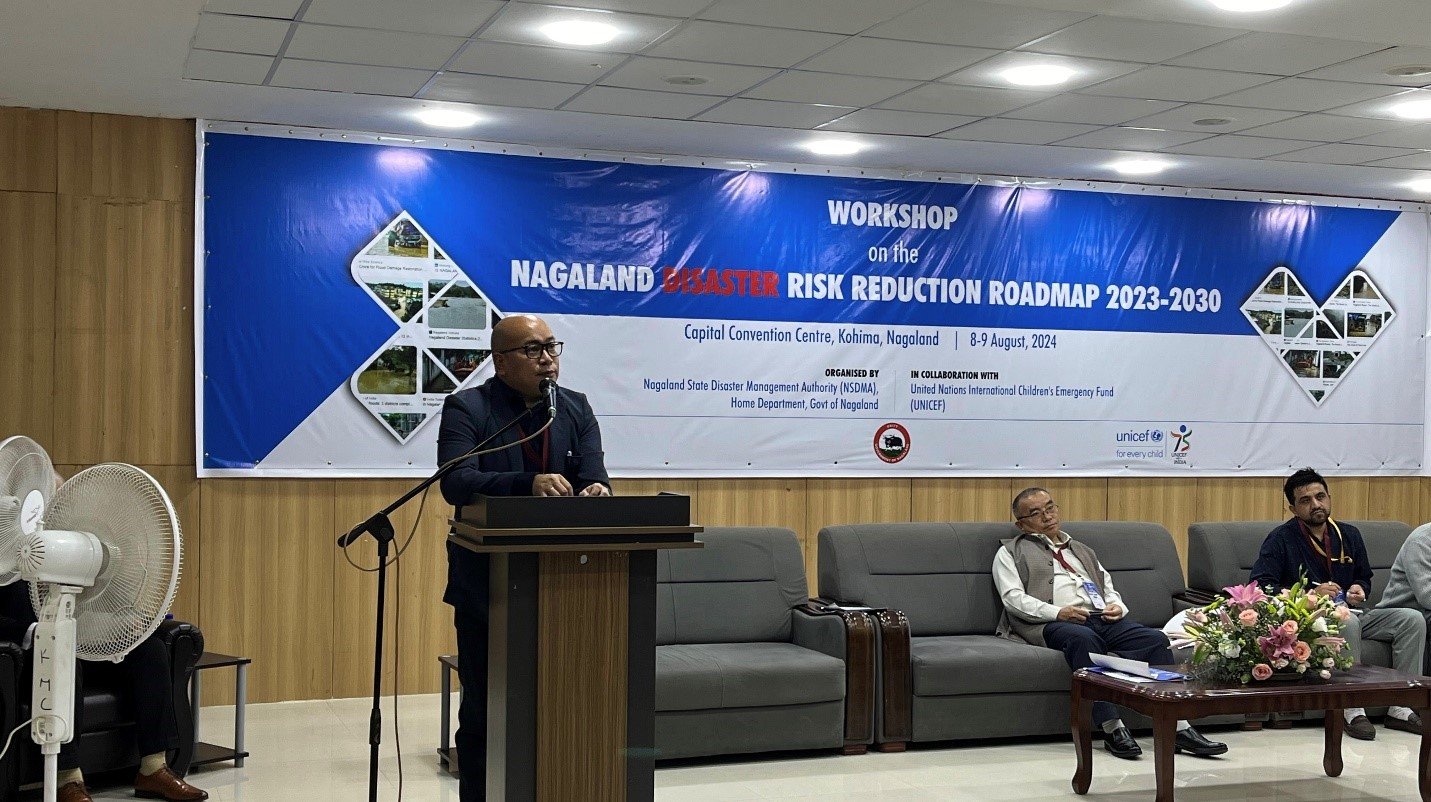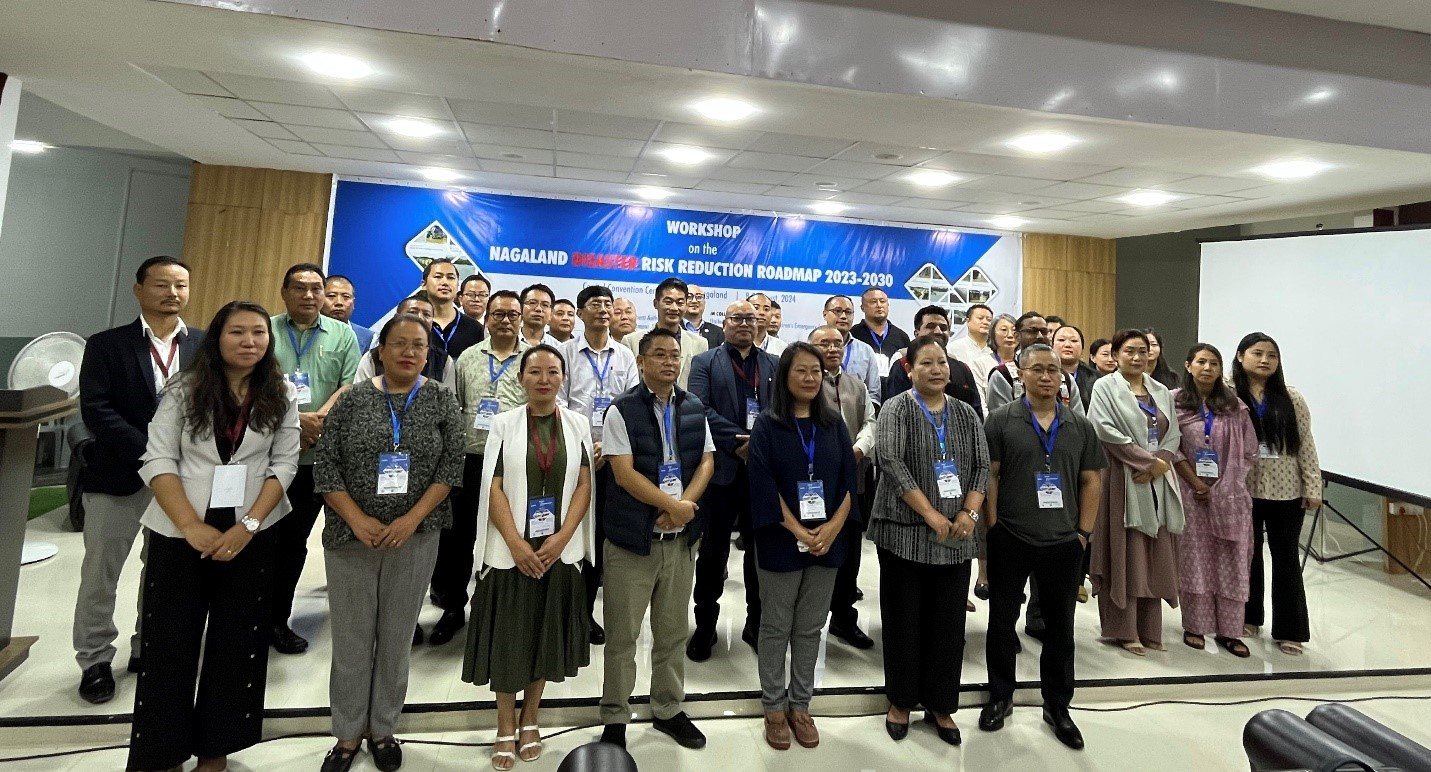The two-day workshop on Nagaland Disaster Risk Reduction (NDRR) Roadmap 2023-2030, organised by the Nagaland State Disaster Management Authority (NSDMA) in collaboration with United Nations International Children’s Emergency Fund (UNICEF), commenced on Thursday at the Capital Convention Centre, Kohima.
The keynote address was delivered by Advisor, New & Renewable Energy and NSDMA, Z. Nyusietho Nyuthe who said that Nagaland is located in the most vulnerable seismic zone and the land is weak and exposed to multiple disaster risk such as prone landslides, flood, earthquake, forest fire and wind. He stated that the NSDMA under the leadership of Chief Minister and Chairman NSDMA, Neiphiu Rio has made NDRR Roadmap, with a hope that it will secure the future of Nagaland from such risks.
He highlighted that this strategic document, designed by NSDMA with the technical support of UNICEF, envisages strategic action plans for different stakeholders. It has estimated the baseline of disaster loss and damage in the state, set DRR actions under each Sendai Framework Policy, defined collaboration from various stakeholders, and set attainable targets in alignment with national and global frameworks such as the Prime Minister’s Ten Point Agenda, the Sendai Framework for Disaster Risk Reduction (SFDRR), and the Sustainable Development Goals (SDGs), the Advisor added.

Nyuthe stated that this workshop, led by NSDMA in collaboration with UNICEF, is an effort to explore the ways required for the progressive implementation of the roadmap in the coming days in its true spirit especially in understanding the relevance of resilient governance systems, efficient social sector services, livelihood resilience, emergency response systems, infrastructural resilience, and risk-informed and the roles of various stakeholders, including the government, academia, private sector, and civil society groups.
encouraged all participants to actively learn the art of result-oriented project proposal formulation methods and techniques, which have been designed exclusively considering Nagaland’s topography, geomorphology and culture in mind.
“By securing sustained commitment of human and financial resources from all stakeholders, we aim to minimize disruptions caused by disasters and enhance our capacity to recover swiftly from any future hazards,” he stated.
The advisor also stated that the launch of the NDRR Roadmap signifies a pivotal advancement towards a safer and more resilient Nagaland, underscoring our collective dedication to strengthening preparedness for preserving our landscape and heritage from disaster risks and ensuring sustainable development.

Joint Chief Executive Officer NSDMA, Johnny Ruangmei, in his welcome address, mentioned that the workshop on NDRR Roadmap aims to provide practical guidance for stakeholders to take actions to minimize the impact of disaster in the state, reduce disaster risks, mitigate the impact of climate change and achieve sustainable development goals.
He hoped that through this workshop Nagaland will also be a lead state in the country to be doing this disaster risk reduction roadmap. He added that developing a good roadmap is good but it also need implementation in action and stressed the importance to this subject as it is centric to any developing world. This is going to really help to sustain infrastructure, development and economy, Ruangmei stated.
Download Nagaland Tribune app on Google Play

The Jt. CEO of NSDMA explained the objectives of the two-day Workshop on Nagaland Disaster Risk Reduction Roadmap such as:
- Develop baseline of disaster loss and damage from 2010-2020: Nagaland is prone to multiple hazards and vulnerable to climate variability and its negative manifestations with increasing complexities due to climate change which induced multiple disasters. As there is no baseline data, no specific departmental guidelines or frameworks at the State/Districts/Village levels for Disaster Management, it remains a challenge towards achieving community resilience. There is a need to prepare action plans to take timely actions for prevention, preparedness and mitigation.
- Identify strategic opportunities for stakeholders (Government, Civil Society Organisations, Academic Institutions, Private Sector and UN Agencies) to collaborate for DRR actions.
- Set realistic short, medium and long term targets for stakeholders based on the baseline data in line with Prime Minister’s Ten Point Agenda on DRR, SFDRR, SDGs and Paris Agreement commitments. This time frames for short term actions may be 0-2 years, 2-4 years for medium term actions, and 4-8 years or more for long term actions which are subjected to changes depending on many factors including changing needs, advances in technology etc,
- Mobilise long-term commitment of human and financial resources from the stakeholders.
Mukunda Upadhyay, senior consultant, DRR, UNICEF India and Rahul Dey, technical expert, UNICEF India are the two resource persons for the two-day workshop on Nagaland Disaster Risk Reduction Roadmap 2023-2030.

The program was chaired by Assistant Manager (Project and Resources), NSDMA, Thejangulie Zao, while Rendemo Shitio Assistant Manager (Response & Communication) pronounced the vote of thanks.
The program was followed by workshop on Disaster Risk Reduction: Concepts, Principles and Methods, Locating Resources for implementation of DRR roadmap in Nagaland, understanding sector thematic plans envisaged in the N-DRE roadmap.

